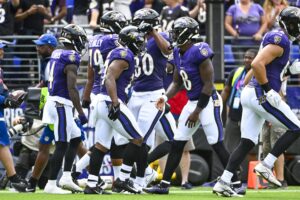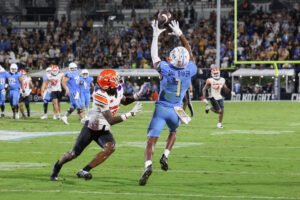Most people accept that rookies struggle in their first season. Players are rarely ever instantly as dominant in the NFL as they were in college. However, there are a few prospects that receive the “can’t miss” label, and they are supposed to have a seamless transition to the pros. Quinnen Williams was one of those prospects.
Quinnen Williams was the best player on the field against LSU. Constantly disruptive, showing violent hands, power and ability to finish plays. Easily a Top-5 pick. https://t.co/jXWUyewc8B
— Jordan Reid (@Jordan_Reid) November 4, 2018
Coming off one of the most dominant college seasons ever, Williams was widely recognized as the first or second-best player in the 2019 draft. The athleticism, size, production, and Alabama pedigree were all there. He epitomized “can’t miss.”
Unfortunately, Williams didn’t perform like a “can’t miss” prospect in his a rookie campaign. He finished the year with a mere 19 pressures (according to Pro Football Focus), which ranked 48th among interior defensive lineman who played at least 463 snaps. Only three of those pressures were sacks.
So… what happened? Should Williams’s early struggles be chalked up to inexperience, or should the Jets be concerned? Lets cut on the tape and find out!
The Jets Did Not Put Williams in a Position to Succeed
— TomKavanaughMU (@TomKavanaugh5) June 2, 2020
At Alabama, Williams showed to be most effective as a pass rusher when he could penetrate gaps and beat the man in front of him. Preferably lined up at three-technique (gap in between the guard and tackle).
— TomKavanaughMU (@TomKavanaugh5) June 2, 2020
— TomKavanaughMU (@TomKavanaugh5) June 2, 2020
— TomKavanaughMU (@TomKavanaugh5) June 2, 2020
— TomKavanaughMU (@TomKavanaugh5) June 2, 2020
The Jets utilized Williams differently. As you can see here, Jets defensive coordinator Gregg Williams regularly uses stunts. Stunts require defensive linemen to attack gaps that they aren’t lined up in to confuse the offensive line. They are typically designed to scheme up a free rusher (unblocked).
In short, Williams does not have the liberty to pin his ears back and get home however he can. His responsibilities are either to occupy a blocker or loop around and be a product of the scheme. That said, it’s hard for a player to be good or bad stunting. It is really more dependent on how the stunt is designed and executed by the entire defensive line.
Stunts do play against Williams’s strengths, however. For example, he is much better playing forward, and stunts usually require him to play laterally. His ability to beat blockers isn’t really being used either.
How Did Williams Fare When He Was Freely Allowed to Rush the Passer?
— TomKavanaughMU (@TomKavanaugh5) June 7, 2020
— TomKavanaughMU (@TomKavanaugh5) June 7, 2020
— TomKavanaughMU (@TomKavanaugh5) June 7, 2020
In traditional pass rush reps, Williams struggled. There just aren’t that many reps to point to where he decisively beats blockers. It’s a lot more pocket pushing, failed bull-rush attempts, and being glued to blockers instead.
Obviously, this is somewhat concerning, given that high-level pass rush production in college generally translates quickly to the NFL. Yet, there could be more to Williams’s situation that was exacerbating his struggles.
Like mentioned before, Gregg Williams asks his defensive linemen to fit his scheme rather than to play towards their strengths. In a Bleacher Report article called The Depths of Myles Garrett written by Dan Pompei, Myles Garrett stated that Gregg Williams also dictates which moves his pass rushers can use.
“Gregg [Williams] was more like: ‘You win with these two moves. I don’t want to see anything else out of you,’ Garrett said. “It’s kind of hard with two moves. I feel like you can’t always be so predictable.”
Now, there isn’t any hard evidence that confirms this to be true about Quinnen Williams, but that’s what it looks like on tape. Williams really only attempts to rush straight down the middle of blockers. Usually, with some sort of bull rush or long arm move. He almost never uses any type swipe, club, or swim move, all of which are more advantageous for quick pass rush wins.
In addition, most opposing offensive lineman knew how to play against Williams. They regularly utilized a quick set (initiate their set early into the rep) to close off the space Williams could’ve used to convert speed to power. Making his job that much harder.
Last Word
It’s no secret that Quinnen Williams did not deliver in his rookie season like many thought he would. However, ignoring the context of his situation would not be fair to him. That being the majority of what the Jets asked him to do was different from what he did well in college.
It’s hard to be optimistic about Williams moving forward until he is put into better situations to utilize his unique pass-rushing ability. Knowing Gregg Williams’ history, it seems unlikely that he is going to change for anyone.
The fact of the matter is, the Jets’ front office should take the brunt of the blame if Quinnen Williams continues to struggle under Gregg Williams. Team builders must know how the players that they draft fit with their coaches. Even if the players are seemingly “can’t miss” prospects.
The Jets should’ve known when they hired Gregg Williams that defensive linemen in his scheme act more as cogs than individual impact players. Therefore, if Quinnen Williams’ role doesn’t change, and they plan on keeping Gregg Williams around, they overvalued Quinnen Williams’s skill set.






